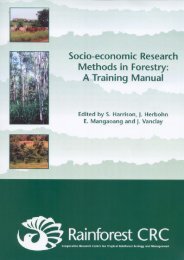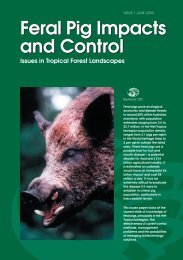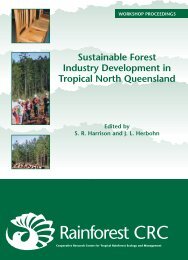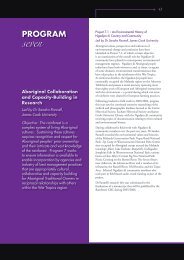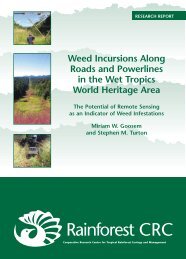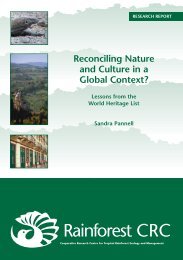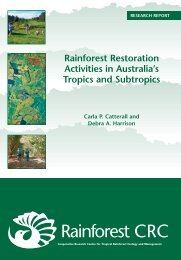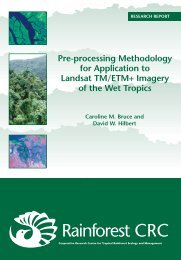Reconciling Nature and Culture in a Global Context? - Rainforest ...
Reconciling Nature and Culture in a Global Context? - Rainforest ...
Reconciling Nature and Culture in a Global Context? - Rainforest ...
Create successful ePaper yourself
Turn your PDF publications into a flip-book with our unique Google optimized e-Paper software.
<strong>Reconcil<strong>in</strong>g</strong> <strong>Nature</strong> <strong>and</strong> <strong>Culture</strong> <strong>in</strong> a <strong>Global</strong> <strong>Context</strong>?Lessons from the World Heritage Listhistoric Ch<strong>in</strong>ese temples, are either the property of the SAR Government or, <strong>in</strong> the case ofthe St Josephs complex, the Dom Pedro V Theatre, <strong>and</strong> the Holy House of Mercy Build<strong>in</strong>g,are owned by the Catholic Church <strong>and</strong> a private <strong>in</strong>stitution. Day-to-day management of theHistoric Centre is the responsibility of the newly formed Heritage Environment ManagementCouncil. Members of this council <strong>in</strong>clude both government representatives, managementboards for each of the <strong>in</strong>dividual heritage properties <strong>and</strong> community associations. The<strong>in</strong>volvement of these community associations po<strong>in</strong>ts to the varied organisations <strong>and</strong> differentsectors of the population with an <strong>in</strong>terest <strong>in</strong> the Historic Centre. For <strong>in</strong>stance, the bufferzones are home to some 36,000 people, <strong>and</strong> these areas comb<strong>in</strong>e both commercial <strong>and</strong>residential use (Figure 16). These zones also conta<strong>in</strong> an array of significant architecturalforms. The build<strong>in</strong>gs <strong>in</strong>clude traditional Ch<strong>in</strong>ese pawnshops, small Ch<strong>in</strong>ese shr<strong>in</strong>es,traditional shop-houses, military structures, some churches <strong>and</strong> chapels, plus the oldcommercial district <strong>and</strong> other public spaces (ICOMOS 2005a). On the other h<strong>and</strong> few, if any,residents <strong>in</strong>habit the 25 build<strong>in</strong>gs <strong>and</strong> squares identified as the key architectural heritage ofthe core zones. While not places of permanent residence, some of the churches <strong>and</strong>temples are still used for religious purposes. Other heritage build<strong>in</strong>gs operate as venues forpublic events, house various government departments <strong>and</strong> private foundations, or functionas a public amenity (e.g. as a library or a museum), visited by locals <strong>and</strong> tourists, alike. AsEvans po<strong>in</strong>ts out, “conservation, property gentrification […] <strong>and</strong> corporate <strong>in</strong>vestment <strong>in</strong>architectural heritage has ensured that there are very few liv<strong>in</strong>g communities <strong>in</strong> the touristiccentres of Venice, Florence, or fashionable museum quarters of London, Paris <strong>and</strong> Madrid”(2005: 39). Unlike the ‘sterilised’ cultural heritage areas that Evans refers to, the HistoricCentre of Macau largely avoids this effect of heritage conservation <strong>and</strong> tourism by the factthat <strong>in</strong>terspersed amongst the largely empty architectural legacy of the East-West encounteris a thriv<strong>in</strong>g residential <strong>and</strong> commercial Macanese community.While local people <strong>and</strong> protected places <strong>in</strong>term<strong>in</strong>gle <strong>in</strong> the core zones, it is also the case,however, that these two zones are dom<strong>in</strong>ated by overtly Portuguese architectural forms,while the buffer zones are predom<strong>in</strong>antly comprised of readily identifiable ‘Ch<strong>in</strong>ese’structures. As this suggests, Portuguese architectural forms dom<strong>in</strong>ate <strong>and</strong> are prioritised <strong>in</strong>the World Heritage listed historic prec<strong>in</strong>ct. This emphasis upon Portuguese heritage is alsoevident <strong>in</strong> the history of the site presented <strong>in</strong> the nom<strong>in</strong>ation document <strong>and</strong> promoted <strong>in</strong> theofficial World Heritage brochure for the site. For all the talk <strong>in</strong> the nom<strong>in</strong>ation <strong>and</strong> list<strong>in</strong>gdocuments of the ‘meet<strong>in</strong>g’ of cultures, long-st<strong>and</strong><strong>in</strong>g cultural ‘encounters’, the ‘<strong>in</strong>terchange’of values <strong>and</strong> the ‘exchange’ of <strong>in</strong>fluences, the Historic Centre of Macau also reflects theseparation <strong>and</strong> segregation of these two cultures.In many respects this ‘dual culture’ (Macau Government Tourist Office 2005: 2) is evident <strong>in</strong>the nature of visitations to the identified architectural focal po<strong>in</strong>ts of the World Heritageproperty. Based on my own experience as a visitor (<strong>and</strong> also researcher) to the area dur<strong>in</strong>gthe stag<strong>in</strong>g of the 4 th East Asia Games <strong>in</strong> Macau, it was apparent that domestic Ch<strong>in</strong>esevisitation is focused upon the A-Ma Temple <strong>in</strong> the south-west section of the centre, <strong>and</strong> to alesser extent upon the other ‘Ch<strong>in</strong>ese’ 54 temples with<strong>in</strong> the historic prec<strong>in</strong>ct, while<strong>in</strong>ternational Western visitors tended to congregate around the many Catholic churches <strong>and</strong>chapels dat<strong>in</strong>g from the period of Portuguese colonialism. Both groups seem to convergeupon the Ru<strong>in</strong>s of St Paul’s <strong>and</strong> the nearby Senado Square. This is not so surpris<strong>in</strong>g giventhat Senado Square is the shopp<strong>in</strong>g centre of Macau, while the Ru<strong>in</strong>s of St Paul’s have awidely-recognised iconic value. Referred to as the ‘Acropolis of Macau’ <strong>and</strong> as an ‘altar tothe city’ <strong>in</strong> the official four-page World Heritage brochure for the site (Macau GovernmentTourist Office 2005: 3), government tourist promotions regularly employ the image of the54 While the official broadsheet visitor brochure produced by Macau Government Tourist Officegenerically identifies the temples <strong>in</strong> the Historic Centre of Macau as 'Ch<strong>in</strong>ese', this label belies therange of religious traditions <strong>and</strong> beliefs, <strong>in</strong>clud<strong>in</strong>g Confucianism, Taoism, Buddhism <strong>and</strong> local folkcults, associated with these temples <strong>and</strong> shr<strong>in</strong>es.53




